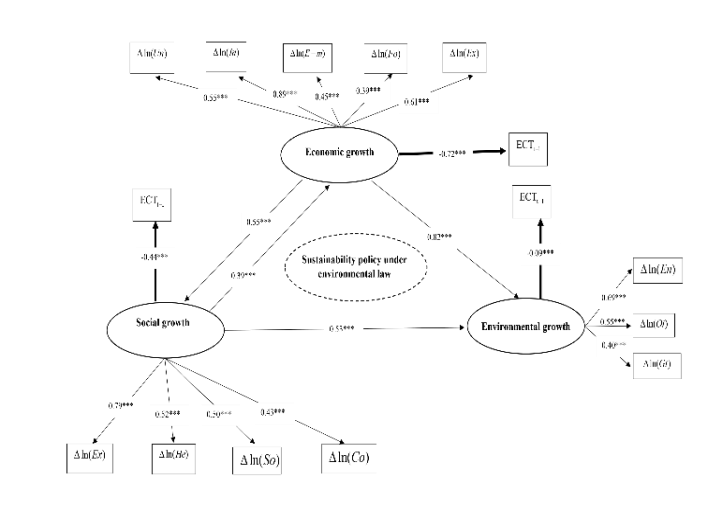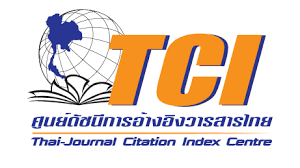A Model for Determining the Effectiveness of Regulatory and Administrative Measures of Sustainability Policy in Thailand
Keywords:
compulsory measures, proactive measures, economic measures, sustainability policy, causal model, sustainability developmentAbstract
The objectives of this research are to 1) create a causal relationship model for political management in order to form sustainable policies under Thai environmental law. and 2) propose a strategic framework for national management to achieve sustainability. The study is designed as a mixed-methods study, which is called Path-Analysis based on an autoregressive Conditional Heteroscedasticity with observed variables (Path-ARCH-xi Model). The study confirms a causal relationship between all three latent variables: economic growth, social growth, and environmental growth, with direct and indirect effects. Notably, each variable's indicator shows a different impact size of the relationship to changes in the variables. Economic growth is significantly influenced by industrial structures, while employment can greatly influence the changes in social growth. In terms of environmental growth, it is greatly influenced by energy consumption. Furthermore, economic growth, followed by social and environmental growth, has the greatest capacity for error correction. Consequently, proactive measures, particularly economic measures, are critical to ensure that environmental law enforcement is used to its full potential, as seen in European countries.
References
The World Bank: Energy Use (Kg of Oil Equivalent Per Capita) Home Page. December 2023, Available: https://data.worldbank.org/indicator/EG.USE.PCAP.KG.OE.
Office of the National Economic and Social Development Council (NESDB). December 2023, Available: http://www.nesdb.go.th/nesdb_en/more_news.php?cid=154&filename=index.
National Statistic Office Ministry of Information and Communication Technology. December 2023, Available: http://web.nso.go.th/index.htm.
Department of Alternative Energy Development and Efficiency. December 2023, Available: http://www.dede.go.th/ewtadmin/
ewt/dede_web/ewt_news.php?nid=47140.
Thailand greenhouse gas management organization (public organization). January 2024, Available: http://www.tgo.or.
th/2015/thai/content.php?s1=7&s2=16&sub3=sub3.
United Nations Framework Convention on Climate Change, UNFCCC, Bonn, Germany. “Global Progress in Environmental Law,” Environmental Policy and Law, vol. 46, no. 1, pp. 23-27, 2016.
Pollution Control Department Ministry of Natural Resources and Environment. Enhancement and Conservation of National Environmental Quality Act, B.E. 2535. December 2023, Available: http://www. pcd. go. th/ info_serv/reg_envi.html.
Pollution Control Department Ministry of Natural Resources and Environment. Navigation of Thai Waterways Act, B.E. 2546. January 2024, Available: http://www.pcd.go.th/info_serv/reg_
envi.html.
Pollution Control Department Ministry of Natural Resources and Environment. Principle 4: In order to achieve sustainable development, environmental protection shall constitute an integral part of the development process and cannot be considered in isolation from it. January 2024, Available: http://infofile.pcd.go.th/ law/Environmental%20law55_1.pdf?
CFID=1741861&CFTOKEN=32274043.
P. Sutthichaimethee, A. Chatchorfa and S. Suyaprom, “A Forecasting Model for Economic Growth and CO2 Emission Based on Industry 4.0 Political Policy under the Government Power: Adapting a Second-Order Autoregressive-SEM,” in J. Open Innov. Technol. Mark. Complex., vol. 5, pp. 69, 2019
P. Sutthichaimethee, and S. Naluang, S., “The Efficiency of the Sustainable Development Policy for Energy Consumption under Environmental Law in Thailand: Adapting the SEM-VARIMAX Model,” Energies, vol. 12, pp. 3092, 2019.
M. Ahmed, K. Riaz, A. Khan Maqbool and S. Bibi, “Energy consumption-economic growth nexus for Pakistan: Taming the untamed,” Renewable and Sustainable Energy Reviews, vol. 52, pp. 890-896, 2015.
B. Ozcan, “The nexus between carbon emissions, energy consumption and economic growth in Middle East countries: A panel data analysis,” Energy Policy, vol. 62, pp. 1138-1147, 2013.
O. Mohiuddin, S. Sarkodie Asumadu, and M. Obaidullah, “The relationship between carbon dioxide emissions, energy consumption, and GDP: a recent evidence from Pakistan,” Cogent Engineering, vol. 3, pp. 1-16, 2016.
K. Alkhathlan and M. Javid, “Energy consumption, carbon emission and economic growth in Saudi Arabia: An aggregate and disaggregate analysis,” Energy Policy, vol. 62, pp. 1525-1532, 2013.
X. Long, E. Naminse Yaw, J. Du, and J. Zhuang, “Nonrenewable energy, renewable energy, carbon dioxide emissions and economic growth in China from 1952 to 2012,” Renewable and Sustainable Energy Reviews, vol. 52, pp. 680-688, 2015.
M. Boutabba Amine, “The impact of financial development, income, energy and trade on carbon emission: Evidence from the Indian economy,” Economic Modeling, vol. 40, pp. 33-41, 2014.
N. Yusoff Mohamed Yusma Bte, , H. Bekhet Ali, S.M. Mahrwarz, “Dynamic Relationships between Energy Use, Income, and Environmental Degradation in Afghanistan,” International Journal of Energy Economics Policy, vol. 10, no. 3, pp. 51-61, 2020.
N. Minh Ngoc, “Foreign Direct Investment and Carbon Dioxide Emissions: Evidence from Capital of Vietnam,” International Journal of Energy Economics Policy, vol. 10, no. 3, pp. 76-83, 2020.
S. Sarkodie Asumadu, P. Owusu Asantewaa, “Recent evidence of the relationship between carbon dioxide emission energy use, GDP, and Population in Ghana: A linear regression approach,” Energy Sources, Part B: Economics, Planning, and Policy, vol. 12, no. 6, pp. 495-503, 2017.
S.S.S. Ali1, R.M. Razman, A. Awang, “The Nexus of Population, Gross Domestic Product Growth, Electricity Generation, Electricity Consumption and Carbon Emissions Output in Malaysia,” International Journal of Energy Economics and Policy, vol. 10, no. 3, pp. 84-89, 2020.
H. Bekhet Aki, A. Matar, T. Yasmin, “CO2 emission consumption, economic growth, and financial development in GCC countries: Dynamic simultaneous equation model,” Renewable and Sustainable Energy Reviews, vol. 70, pp. 117-132, 2017.
S. Nasreen, S. Anwar, I. Ozturk, “Financial stability, energy consumption and environmental quality: Evidence from South Asia economies,” Renewable and Sustainable Energy Reviews, vol. 67, pp. 1105-1122. 2017.
I. Ozturk, A. Acaravci, “The long-run and causal analysis of energy, growth, openness and financial development on carbon emission in Turkey,” Energy Economics, vol. 36, pp. 262-267, 2013.
H. Taher, “Financial Development and Economic Growth Impact on the Environmental Degradation in Lebanon,” International Journal of Energy Economics and Policy, vol. 10, no. 3, pp. 311-316, 2020.
S. Farhani, S. Solarin Adebola, “Financial development and energy demand in the United States: New evidence from combined cointegration and asymmetric causality tests,” Energy, vol. 134, pp. 1029-1037, 2017.
S. Sarkodie Asumadu, P. Owusu Asantewaa, “The potential and economic viability of wind farms in Ghana,” Energy Sources, Part A: Recovery, Utilization, and Environmental Effects, vol. 38, no. 5, pp. 1-15, 2016.
N. Aeknarajindawat, B. Suteerachai, P. Suksod, “The Impact of Natural Resources, Renewable Energy, Economic Growth on Carbon Dioxide Emission in Malaysia,” International Journal of Energy Economics and Policy, vol. 10, no. 3, pp. 211-218, 2020.
Y. Sulub Ahmed, Z. Zarinah Hamid, M.N.M. Mior Nasir Mior Nazri, “Renewable Energy Supply and Economic Growth in Malaysia: An Application of Bounds Testing and Causality Analysis,” International Journal of Energy Economics and Policy, vol. 10, no. 3, pp. 255-264, 2020.
M. Saboohi, “Exploring the Compensation Plans Under International Laws from Offshore Oil Facilities and Relationship between Oil Production, Trade and Carbon Emission: An Evidence from Global Economy,” International Journal of Energy Economics and Policy, vol. 10, no. 3, pp. 265-273, 2020.
D.A. Dickey, and W.A. Fuller, “Likelihood ratio statistics for autoregressive time series with a unit root,” Econometrica, vol. 49, pp. 1057–1072, 1981.
S. Johansen and K. Juselius, “Maximum likelihood estimation and inference on cointegration with applications to the demand for money,” Oxford Bulletin of Economics and Statistics, vol. 52, pp. 169–210, 1990.
S. Johansen, Likelihood-Based Inference in Cointegrated Vector Autoregressive Models. New York: Oxford University Press, 1995
J. MacKinnon, “Critical Values for Cointegration Test. In Long-Run Economic Relationships, Engle, R., Granger, C., Eds,” Oxford: Oxford University Press, 1991.
P. Sutthichaimethee, “Forecasting Economic, Social and Environmental Growth in the Sanitary and Service Sector Based on Thailand’s Sustainable Development Policy,” Journal of Ecological Engineering, vol. 19, no. 1, pp. 205-210, 2018.
P. Sutthichaimethee, “Model of Environmental Problems Priority Arising from the Use of Environmental and Natural Resources in Machinery Sectors of Thailand,” Environmental and Climate Technologies, vol. 17, no. 1, pp. 18–29, 2016.
P. Sutthichaimethee, “Varimax Model to Forecast the Emission of Carbon Dioxide from Energy Consumption in Rubber and Petroleum Industries Sectors in Thailand,” Journal of Ecological Engineering, vol. 18, no. 3, pp. 112–117, 2017.
P. Sutthichaimethee, and D. Ariyasajjakorn, D. “Forecasting Model of GHG Emission in Manufacturing Sectors of Thailand,” Journal of Ecological Engineering, vol. 18, no. 1, pp. 18–24, 2017.
P. Sutthichaimethee and D. Ariyasajjakorn, “Forecast of Carbon Dioxide Emissions from Energy Consumption in Industry Sectors in Thailand,” Environmental and Climate Technologies, vol. 22, no. 1, pp. 107–117, 2018.
P. Sutthichaimethee and D. Ariyasajjakorn, “The revised input-output table to determine total energy content and total greenhouse gas emission factors in Thailand,” Journal of Ecological Engineering, vol. 18, no. 6, pp. 166–170, 2017.
W. Na sorn, S. Sirivithayapakorn, S. Polruang, and N. Vongthanasunthorn, “Five-dimensional Strategic Environmental Assessment (SEA)Action Framework Toward Sustainable River Basin Management Under Climate Change,” ENGINEERING ACCESS, Vol. 9, no. 2, pp. 193-208, 2023.
P. Sutthichaimethee and K. Kubaha, “A Relational Analysis Model of the Causal Factors Influencing CO2 in Thailand’s Industrial Sector under a Sustainability Policy Adapting the VARIMAX-ECM Model,” Energies, vol. 11, no. 7, pp. 1704, 2018.
P. Sutthichaimethee, W. Tanoamchard, P. Sawangwong, P. Pachana, N. Witit-Anun, “Environmental problems indicator under environmental modeling toward sustainable development,” Global Journal of Environmental Science and Management (GJESM), vol. 1, no. 4, pp. 325-332 .2015.
W. Enders, “Applied Econometrics Time Series; Wiley Series in Probability and Statistics, Tuscaloosa: University of Alabama, 2010.
A.C. Harvey, “Forecasting, Structural Time Series Models and the Kalman Filter,” Cambridge: Cambridge University Press, 1989.
F.A.L. Pacheco, L.F. Sanches Fernandes, “The multivariate statistical structure of DRASTIC model,” Journal of Hydrology, vol. 476, pp. 442-459, 2013.

Downloads
Published
How to Cite
Issue
Section
License

This work is licensed under a Creative Commons Attribution-NonCommercial-NoDerivatives 4.0 International License.








